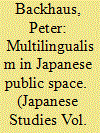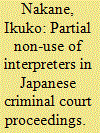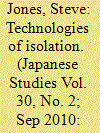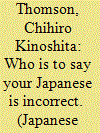|
|
|
Sort Order |
|
|
|
Items / Page
|
|
|
|
|
|
|
| Srl | Item |
| 1 |
ID:
098372


|
|
|
|
|
| Publication |
2010.
|
| Summary/Abstract |
Touch, as it is conventionally conceived, appears to be lacking in everyday Japanese intimate relationships, which are accordingly commonly characterised in terms of subtle non-tactile and non-verbal forms of communication; feelings are expected to be inferred. However, it is unclear as to how such forms manifest feelings of closeness in the first place. This paper explores the embodied experience in the intimate spaces of the Japanese family. Japanese parent-child relationships help us to become acquainted with different ways of understanding bodily intimacy and touch. The paper explores the cultural meaning of touch in Japanese bodily intimacy, particularly where the child is under five years old, and presents an embodied and sensuous understanding of the touch which informs parent-child relationships as the child grows older. Certain phenomenological tools are used helping to develop the notion of a blurring of the boundaries between bodies in Japanese bodily intimacy.
|
|
|
|
|
|
|
|
|
|
|
|
|
|
|
|
| 2 |
ID:
100296


|
|
|
|
|
| Publication |
2010.
|
| Summary/Abstract |
Language standardization lies at the heart of Japanese modernity. And numerous aspects of language development intended to fit the modern Japanese state intersect to regiment the linguistic imaginary regarding women's speech. Focus on Yamanote Tokyo-based joseigo ('women's language'), Standard Japanese and certain urban Kansai dialects in popular text and televisual representations of romantic heroines in geographically and linguistically peripheral areas of Japan has been documented, but has left the issue of linguistic masculinity and the romantic hero unexplored. The relation of male speakers to hyo-jungo was assumed and 'masculine' speaking practices as broadcast in public space have received little attention despite a popular understanding that certain forms (e.g., ore 'I', and assertive sentence final particle zo) are 'masculine' in effect. Here, we examine images of manly men in contemporary romantic representations set in dialect-speaking areas to illustrate the linkages between the romantic hero and the use of Standard Japanese masculine forms and to offer insight into the underexplored set of possibilities for male speakers circulated in popular media.
|
|
|
|
|
|
|
|
|
|
|
|
|
|
|
|
| 3 |
ID:
098373


|
|
|
|
|
| Publication |
2010.
|
| Summary/Abstract |
This article examines the creation of entrepreneurial male subjects in Japan's host clubs. Based on my ethnographic study, I argue that hosts' entrepreneurship is constituted by commodifying themselves. This paradoxical - commodified, yet entrepreneurial - male subject is embedded in the new possibilities and constraints posed by Japan's neoliberal restructuring and global economic trends. Hosts, who dream of earning fast cash and achieving upward class mobility, perceive the hosting business as a gateway to success, fame, and luxurious lifestyles. As a result, they 'voluntarily' commodify themselves and feed into the club's profit-making. They are also exploiting the consumer logic of desirability and the neoliberal values of entrepreneurship. By doing so, they hope to better position themselves in contrast to the work ethic and status of Japan's conventionally hegemonic masculine icon, the Salaryman. I contend that neoliberal reform in Japan is not a mere politico-economic reaction to globalization, but a socio-historically specific situation in which individual desires, Japan's social values and ethics, and global economic trends discursively intersect, align, and produce a new mode of attachment to individual freedom and flexible accumulation of capital.
|
|
|
|
|
|
|
|
|
|
|
|
|
|
|
|
| 4 |
ID:
098369


|
|
|
|
|
| Publication |
2010.
|
| Summary/Abstract |
Chinese emigrants or kaky? occupy an important but little acknowledged niche in the history of modern Japan. They mediated Japan's relations with China and the West in the Meiji period, they competed against Japanese economic interests in Korea before and after it became a Japanese colony, and they were a controversial source of labour for the Japanese economy. This article recovers the history of Chinese migrants in Japan and Korea in the late nineteenth and early twentieth century paying special attention to the ambivalent Japanese attitude toward them. This study not only contributes to a fuller understanding of modern Japanese history but also offers historical insights into Japan-China relations in the twenty-first century as Chinese migration to Japan again causes public concern.
|
|
|
|
|
|
|
|
|
|
|
|
|
|
|
|
| 5 |
ID:
098376


|
|
|
|
|
| Publication |
2010.
|
| Summary/Abstract |
This article offers historical insights into the political philosophy, electoral strategies and commitment to 'change' politics of Kan Naoto, who in June 2010 became leader of the Democratic Party of Japan and the nation's new prime minister. The preface introduces an unpublished paper that the author wrote immediately after Kan's first electoral success in 1980, not long after the author's extensive personal interviews with the then budding political aspirant. That paper, which follows, reveals how Kan's entry into the national political system he now leads is quite atypical of Japanese politicians generally and certainly of most of his predecessor prime ministers who were supported by a powerful mix of wealth and connections, often through inheritance. Instead Kan is a 'self-made' politician, the first to reach national leadership initially through participatory democracy: electoral organizations based on citizen movements and grassroots involvement in national politics. The epilogue that follows considers the possible consequences of this style of political advancement for how Kan operates as leader of his party, the national political system, and the Japanese nation.
|
|
|
|
|
|
|
|
|
|
|
|
|
|
|
|
| 6 |
ID:
100292


|
|
|
|
|
| Publication |
2010.
|
| Summary/Abstract |
This paper investigates regimented language choices at Naha Airport in Okinawa Prefecture in order to study how these language choices relate to language ideology on one hand and to creating a self-supporting language ecology of maximum diversity on the other. Issues of power and ideology underlie the language choice and the language ecology which evolve from them, as well as ideologically erased language choices. Despite its multilingual heritage and the presence of a large English-speaking community of US military personnel on the island, Naha Airport reproduces ideas of individual and societal monolingualism with regard to Japan as well as to neighbouring countries. Owing to entrenched nationalist ideology and language attitudes, a change in such language regimentation cannot be envisaged in the near future, despite several shortcomings in the present linguistic organization of Naha Airport. Officially regulated public spaces accessible to all, such as Naha Airport, can play a key role in readjusting and re-evaluating specific behaviours and values.
|
|
|
|
|
|
|
|
|
|
|
|
|
|
|
|
| 7 |
ID:
100294


|
|
|
|
|
| Publication |
2010.
|
| Summary/Abstract |
Today, electronic government is being pursued at both national level (denshi seifu) and local level (denshi jichitai) in Japan. It is therefore useful to examine how local administrations communicate with the public in the Internet age. This paper examines foreign-language provision on local government websites, concentrating on the 47 prefectures. An overview is supplemented by more detailed discussion of several selected websites, looking at aspects such as the languages available, content, target audiences, translation and efforts to make Japanese-language information more accessible to non-native speakers. Local governments increasingly have to take into account the linguistic needs of the growing numbers of foreign residents in their communities. Making provision for foreign residents is, however, not the only reason for local governments to use languages other than Japanese on their websites. Examining these websites in terms of which languages are used and the type of material presented offers insights into broader issues of internationalisation, multiculturalism and globalisation as experienced and managed at local level.
|
|
|
|
|
|
|
|
|
|
|
|
|
|
|
|
| 8 |
ID:
100293


|
|
|
|
|
| Publication |
2010.
|
| Summary/Abstract |
This paper looks at multilingual signs and what these signs have to tell us about multilingualism in Japan in general. Working with a larger sample of signs collected in central Tokyo, it is shown how these signs can be read to reflect larger transformations in Japanese society and its linguistic make-up at large. Four interrelated factors are identified as indicative of these transformations: (1) favourable attitudes toward foreign languages, (2) official internationalisation policies, (3) growing ethnicisation in some areas, and (4) a recent interest in Korean culture and language.
|
|
|
|
|
|
|
|
|
|
|
|
|
|
|
|
| 9 |
ID:
100299


|
|
|
|
|
| Publication |
2010.
|
| Summary/Abstract |
This paper reports findings of a study which examined court proceedings with the presence of an interpreter in Japanese criminal courts. With the increasing awareness of language rights over the last decade and the recent introduction of the saiban-in (lay judge) system, courtroom discourse involving non-Japanese speaking background (NJSB) people is increasingly under scrutiny as an issue of language in public spaces, and improvements have been made in provision of legal interpreting. The present study focuses on partial non-use of the interpreter, an aspect of court interpreting that has been little discussed and hidden behind the published statistics and public discourses on legal interpreting in so-called 'foreigner cases'. It examines which stages of trials are interpreted and which are in Japanese only, and presents an analysis of courtroom interaction involving an NJSB defendant without interpreter mediation. Using Halliday's register framework, the paper discusses courts' decisions regarding partial non-use of interpreters and problems associated with it. While the partial use of interpreters for the highly technical legal genre indicates the courts' effort to provide fair trials for second language speakers, it is argued that a simplistic view of register overlooks the risks involved in not using an interpreter in ostensibly non-technical questioning of the defendant.
|
|
|
|
|
|
|
|
|
|
|
|
|
|
|
|
| 10 |
ID:
100295


|
|
|
|
|
| Publication |
2010.
|
| Summary/Abstract |
Taking as its premise the conceptualisation of the Internet as a virtual public space, this article focuses on the manner in which language play is manifested through the manipulation of linguistic (and particularly orthographic) conventions in informal Computer Mediated Communication (CMC) and in cell phone emails in Japan. The flexibility of the Japanese writing system, with its three official scripts often also combined with Arabic numerals and the Roman alphabet, lends itself very well to ludic use of orthography to create a desired effect. Users therefore play with standard orthographic conventions in cyberspace to an extent not possible for single alphabet users, subverting norms in order to create eye-catching effects which strengthen in-group solidarity through play and in some cases act as markers of subcultural identities. From time to time it is suggested that innovative use of orthography in cyberspace is a product of new electronic technologies. I argue, however, that language play of this kind, far from being new to Japan, builds on an already existing tradition of orthographic creativity facilitated by the nature of the writing system, the only real difference being that the practice has now moved into the much wider public arena of cyberspace.
|
|
|
|
|
|
|
|
|
|
|
|
|
|
|
|
| 11 |
ID:
100291


|
|
|
|
|
| Publication |
2010.
|
| Summary/Abstract |
Public signs (both advertising and informational) are analyzed here as narrative. This allows us to see the parallels between abbreviated texts in public spaces and extended discourse that has a long history of analysis. It also reveals parallels between literary and linguistic treatment of discourse. Included in the analysis is a description of how reference and indexicality function in the discourse we see all around us on what might be called 'the linguistic landscape', as well as how point of view operations, focalization, and voice are manipulated to authors' specific ends.
|
|
|
|
|
|
|
|
|
|
|
|
|
|
|
|
| 12 |
ID:
098374


|
|
|
|
|
| Publication |
2010.
|
| Summary/Abstract |
Louisa May Alcott's famous novel Little Women has been translated into Japanese several times. It was first rendered accessible to Japanese readers at the end of the Meiji period in 1906 by an amateur translator, Kitada Sh ho, about whom very little is known. This article discusses how Kitada's version introduced the concept of the Christian home and the idea of modern womanhood to the Japanese audience. The approach taken by the translator throws valuable light on the cultural norms of Meiji society. Men held specific expectations about the contribution women could make in their domestic roles to the modern nation, encapsulated in the Good Wife Wise Mother (ry?sai kenbo) ideology propagated through the girls' education system. The Kitada translation upheld these expectations, but at the same time its publication spread enthusiasm among educated young Japanese women to contribute prose to the flora of girls' magazines (sh?jo zasshi) appearing around the turn of the twentieth century. Thus it appears also to have helped them escape the Meiji period mindset surrounding literature, which suppressed the true voices of women and confined them to roles as translators.
|
|
|
|
|
|
|
|
|
|
|
|
|
|
|
|
| 13 |
ID:
098370


|
|
|
|
|
| Publication |
2010.
|
| Summary/Abstract |
In this investigation of the Japanese film Kairo, I contemplate how the horrors present in the film relate to the issue of self, by examining a number of interlocking motifs. These include thematic foci on disease and technology which are more intimately and inwardly focused that the film's conclusion first appears to suggest. The true horror here, I argue, is ontological: centred on the self and its divorcing from the exterior world, especially founded in an increased use of and reliance on communicative technologies. I contend that these concerns are manifested in Kairo by presenting the spread of technology as disease-like, infecting the city and the individuals who are isolated and imprisoned by their urban environment. Finally, I investigate the meanings of the apocalypse, expounding how it may be read as hopeful for the future rather than indicative of failure or doom.
|
|
|
|
|
|
|
|
|
|
|
|
|
|
|
|
| 14 |
ID:
098375


|
|
|
|
|
| Publication |
2010.
|
| Summary/Abstract |
For many years, victims of Japanese wartime enforced labour have published or contributed to collections of memoirs and testimonies. These testimonies and the subsequent historical analyses by researchers since the early 1960s have often been framed against contemporaneous issues. What started out as a way to help stir activism and a historical consciousness among resident Koreans in Japan has morphed into a struggle over textbooks and a fight against historical revisionism. This article identifies some of the historical and methodological issues present in constructing a historical discourse of enforced Korean labour that began in 1939. It reassesses the politicised meaning of the phrase ky?sei renk? (forced recruitment) and argues that both researchers, who acknowledge the wartime system of enforced labour, and revisionists, who deny it, have cogent arguments. These arguments, however, are often narrow in scope and fail to take into account testimonies that present a more complex picture of the period and system in question.
|
|
|
|
|
|
|
|
|
|
|
|
|
|
|
|
| 15 |
ID:
100298


|
|
|
|
|
| Publication |
2010.
|
| Summary/Abstract |
This paper discusses the Japanese language used by JSL learners in Japan, while examining JSL classrooms as public space. It draws upon JSL literature, Japanese textbooks and their discourses to find the kinds of Japanese that are taught and used in JSL classrooms and how they are presented and consumed, and it observes how diversity in learners' language is dealt with inside and outside of JSL classrooms in Japan, keeping in view the danger of 'colonisation' of classrooms. It will then study new developments where JSL speakers are participating in development of their own 'third space', which values hybridity more than diversity, and in turn the continuous re-construction of the public space.
|
|
|
|
|
|
|
|
|
|
|
|
|
|
|
|
| 16 |
ID:
098371


|
|
|
|
|
| Publication |
2010.
|
| Summary/Abstract |
In recent years, Japanese popular culture has received much attention both inside and outside the academy. Its success overseas has contributed to theories of transnational cultural flow, 'soft power' and 'Gross National Cool'. At the same time, public opinion of fans, both in Japan and overseas, remains low. This article attempts to rescue fandom from its current association with social ostracism, placing it instead in a logical structure of a historical consumer culture in Japan and in the West. Fandom can be considered a rational consumer strategy, rather than a deviant psychological attribute, when considered within the hyper-developed context of a media-saturated, late-capitalist consumer society. Fandom, when viewed from this perspective, can be distinguished from pathological behaviour and focuses on pleasure, the pursuit of social capital, and individualised identity building, especially in a society where traditional corporate groups such as the family or the workplace no longer offer the same attraction.
|
|
|
|
|
|
|
|
|
|
|
|
|
|
|
|
|
|
|
|
|